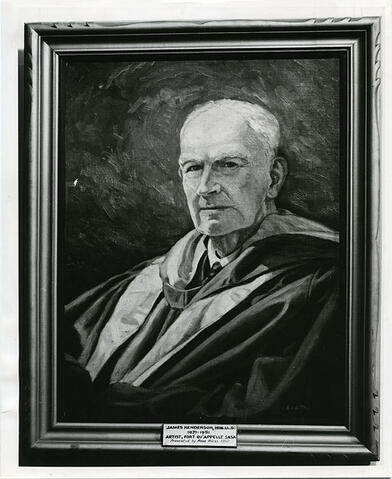
Title and statement of responsibility area
Titel
Paintings - James Henderson Portrait
Algemene aanduiding van het materiaal
- Graphic material
Parallelle titel
Overige titelinformatie
Title statements of responsibility
Titel aantekeningen
Beschrijvingsniveau
Stuk
archiefbewaarplaats
referentie code
Editie
Editie
Edition statement of responsibility
Class of material specific details area
Statement of scale (cartographic)
Statement of projection (cartographic)
Statement of coordinates (cartographic)
Statement of scale (architectural)
Issuing jurisdiction and denomination (philatelic)
Datering archiefvorming
Datum(s)
-
nd (Vervaardig)
Fysieke beschrijving
Fysieke beschrijving
1 photograph : b&w ; 25.5 x 20.5 cm
Publisher's series area
Title proper of publisher's series
Parallel titles of publisher's series
Other title information of publisher's series
Statement of responsibility relating to publisher's series
Numbering within publisher's series
Note on publisher's series
Archivistische beschrijving
Naam van de archiefvormer
Geschiedenis beheer
Bereik en inhoud
Image of painting of James Henderson by Ernest Luthi.
Bio/Historical Note: James Henderson was born in 1871 in Glasgow, Scotland. He enjoyed sketching and drawing from an early age, and began an apprenticeship in lithography when he was 16 years old (1887-1894) while taking evening classes at the Glasgow School of Art. He worked in London as a commercial artist, lithographer, and engraver (1894-1909) and in 1910, immigrated to Canada. Henderson worked briefly as a lithographic artist in Winnipeg before moving to Regina, Saskatchewan and then to nearby Fort Qu'Appelle in 1916. The picturesque Fort Qu'Appelle alley, as well as Henderson's trips through western Canada and Ontario, provided him with much inspiration for his oil and watercolour landscapes. Henderson is also known for his portraits of Cree, Sioux, Saulteaux, and Assiniboine people in Saskatchewan and Alberta. These portraits gained national and international recognition — a first for a Saskatchewan artist — and Henderson was also the first Saskatchewan artist who made his living from his art practice alone. Henderson's work was exhibited mainly in Saskatoon and Regina, but also in Ontario at the National Gallery (1927, 1928, 1930, 1936), the Montreal Museum of Fine Arts (1931, 1932, 1936), and in Ontario, Alberta, Winnipeg, and London, England. He exhibited portraits at the British Empire Exhibitions at Wembley in 1924 and 1925, and with the Royal Canadian Academy in 1936. Henderson's work is represented in the collections of the National Gallery of Canada (Ottawa), MacKenzie Art Gallery (Regina), Mendel Art Gallery (Saskatoon), Edmonton Art Gallery, Calgary Public Library, University of Saskatchewan, and Glenbow Museum (Calgary), among others. Among the honours Henderson received was being named Honourary Chief at Fort Qu’Appelle’s Standing Buffalo Reserve with the name Wiciteowapi Wicasa or “the man who paints the old men,” and receiving an honorary degree from the University of Saskatchewan in May 1951. Henderson died in Regina later that year. Henderson is the subject of a significant retrospective exhibition organized by and first exhibited at the Mendel Art Gallery in 2009. A website dedicated to his life and work has been produced in conjunction with the exhibition, James Henderson: Wicite Owapi Wicasa: the man who paints the old men.
Bio/Historical Note: Ernest Luthi was born in Zeebach, Switzerland in 1906. He came with his family to homestead in Canada in 1914, settling near Punnichy, Saskatchewan. From the age of 15, he worked in farming, carpentry, house and sign painting, and on the railroad over the next twenty years to support his art practice. Though Luthi was mostly self-taught, he did take correspondence courses in illustration from the Washington School of Art in the 1920s, and night classes in Pittsburgh, Pennsylvania at the Art Institute of Pittsburgh, earning his diploma in 1928. In 1951, Luthi became a full-time artist. Luthi's work has been exhibited in Saskatchewan since 1950. His landscape paintings in oil and watercolour reflect his interest in Saskatchewan's vast skies, prairie buildings, and farming life. He often painted these from his own photographs or pastel sketches. Luthi's paintings are represented in collections including the Government of Saskatchewan, MacKenzie Art Gallery (Regina), Mendel Art Gallery (Saskatoon), Saskatchewan Arts Board, and the University of Saskatchewan. In 1975, Luthi received an Honorary Doctor of Laws degree from the University of Regina. Luthi died in Punnichy, Saskatchewan, in 1983. His home there, which he built in 1938, was designated a heritage property and converted into an art gallery.
Aantekeningen
Materiële staat
Directe bron van verwerving
Ordening
Taal van het materiaal
Schrift van het materiaal
Plaats van originelen
Beschikbaarheid in andere opslagformaten
Restrictions on access
Termen voor gebruik, reproductie en publicatie.
Other terms: Responsibility regarding questions of copyright that may arise in the use of any images is assumed by the researcher.

